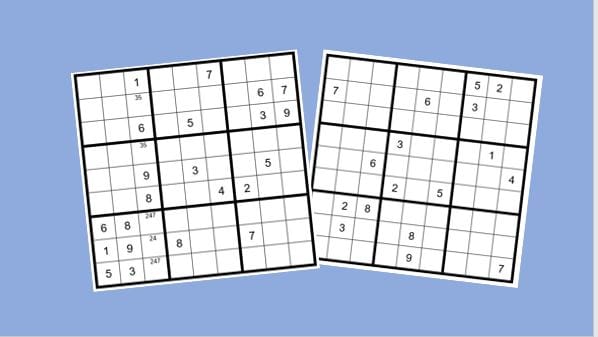Puzzles #73 & #74
by: Dan LeKander
Welcome to a new year of Sudoku articles and an opportunity to further hone your Sudoku skills. We have a special treat this year, starting with this issue. Please welcome the “Clueless” series.
____________________________
DAN’S 8-STEP APPROACH TO SOLVING ALL SUDOKU PUZZLES
Once you have completed the puzzle, to the extent that you have filled-in all obvious answers and have written all potential options across the top of the unsolved cells (PUZZLE PREPARATION), Dan recommends the following Steps to complete the puzzle.
Step 1: Sudoku Pairs, Triplets and Quads – See September 2015
Step 2: Turbos & Interaction – See October 2015
Step 3: Sudoku Gordonian Rectangles and Polygons – See November 2015
Step 4: XY-Wings & XYZ Wings – See December 2015
Step 5: X-Wings – See January 2016
Step 6: DAN’S YES/NO CHALLENGE
Step 7: DAN’S CLOSE RELATIONSHIP CHALLENGE
Step 8: AN EXPANSION OF STEP 7Steps 1-5 are relatively common techniques and are explained in the TI LIFE articles above. Steps 6-8 are covered in detail, in Dan’s book.
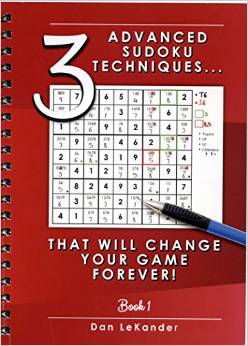
Once you have found all initial clues and are ready to fill in the options for the un-solved cells, you find yourself asking “did I really find all of the obvious and not-so-obvious clues”. The difference between finding one more clue and not finding it can cost you addition-al time to solve the puzzle, sometimes substantial additional time.
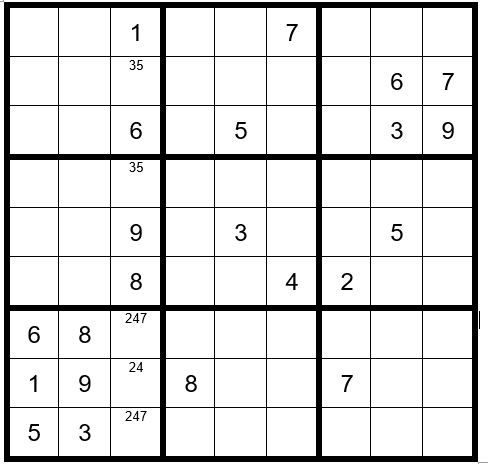
Clueless?
Does this puzzle have any more clues? The answer is yes. So, we now have a puzzle within the puzzle. Puzzle #73 below has been started and is at a point of searching for any additional clues. Can you find a clue? The answer follows below after the conclusion of Puzzle #74, the feature puzzle for January.
Puzzle # 74
Puzzle #74 below will help refresh what we have learned last year. Step 6 & 7 are lifesavers when confronted with difficult puzzles. So, give this a go, or follow our lead.
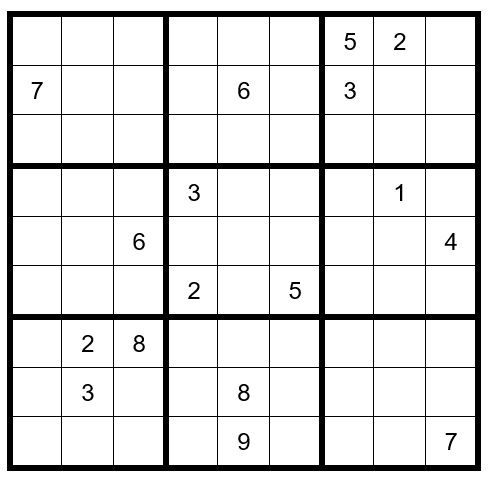
PUZZLE PREPARATION
Prior to utilizing techniques first complete the 5 Steps of Puzzle Preparation …
- FILL IN DATA FROM OBSERVATIONS
- FILL IN OBVIOUS ANSWERS
- FILL IN NOT-SO-OBVIOUS ANSWERS
- MARK UNSOLVED CELLS WITH OPTIONS THAT CANNOT EXIST IN THOSE CELLS
- FILL IN THE OPTIONS FOR THE UNSOLVED CELLS
We will complete all of the first 4 steps in the order we observe them.
We will start with the 1’s and navigate through 2’s to 9’s, then repeat the process until we conclude all Puzzle Preparation Step 1-4 clues.
The first thing we observe is that C6R4 (cell in column 6, row 4) =6 (obvious answer). C3R8=7. Options for C4R5 & C6R5 are now 89, so enter them at the top of those cells.
Options for the remaining cells in box 5 are limited to 147. Options are now C5R4=47, C5R5=17 & C5R6=147.
The remaining unsolved cells in column 5 are limited to options 235. There is already a 2 & 5 in row 1, so C5R1=3. There is a 2 in row 7, so C5R7=5, and C5R3=2. C3R2=2.
Now your grid should look like Example #74.1 below:
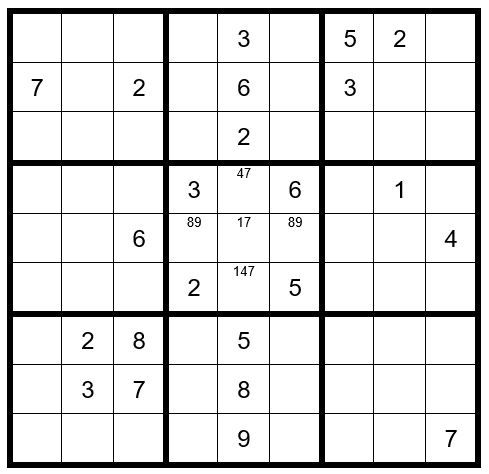
In box 3 a 7 can only exist as an option in C7R3 or C8R3; therefore, a 7 cannot exist as an op-tion in C4R3 or C6R3. Indicate this by placing a small 7 in the bottom of those cells.
In box 7 a 9 can only exist as an option in cells C1R7 or C1R8; therefore, a 9 cannot exist as an option in C1R1, C1R3, C1R4 or C1R6 (we already know that C1R5 cannot have a 9 as an option because of the obvious pair 89 in C4R5 & C6R5).
Now your grid should look like Example #74.2 below:
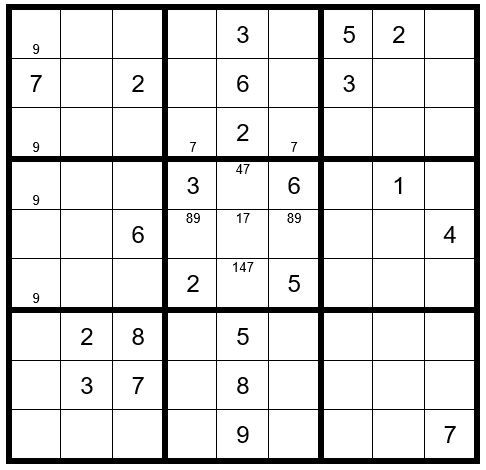
This concludes Puzzle Preparation steps 1-4. We will now fill in the options for the unsolved cells, giving us Example #74.3 below:
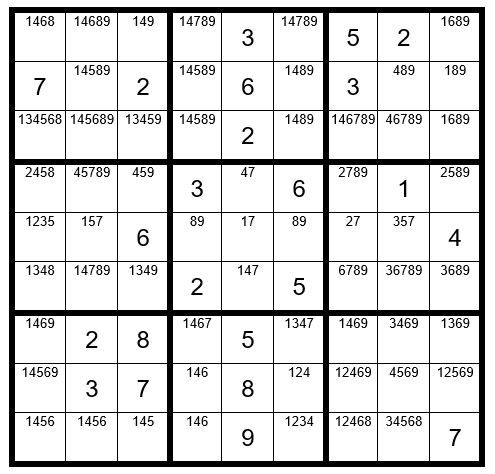
STEPS 1-5
Searching rows, columns and boxes for pairs, triplets, quads and quints leads us to see that in row 9 four cells are limited to the four options 1456, an obvious quad.
This means the remaining unsolved cells in row 9 cannot have options 1456. Now options are as follows … C6R9=23, C7R9=28 & C8R9=38.
In column 9 there are only two unsolved cells that have options 2 & 5. This is a hidden pair. You may change the options for C9R4 & C9R8 to 25. Now your grid should look like Example #74.4 below:
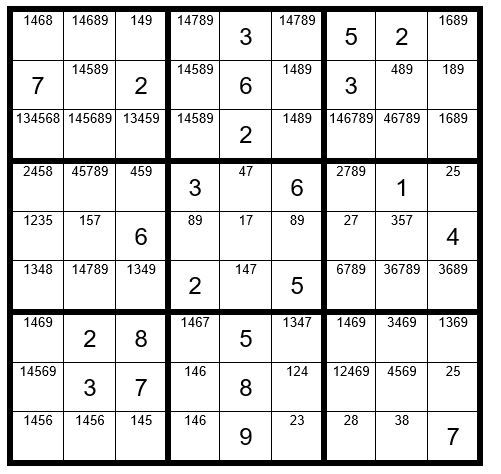
There are no additional Step 1-5 clues, and there are no productive Step 6 clues, so we will move on the Step 7, Dan’s Close Relationship Challenge.
To begin a Step 7 exercise, we will pick any 2-digit unsolved cell to be our “driver cell”, and we will pick a sequence to follow. In Example #74.3 above I chose C9R4 with sequence 2,5.
The first number in the sequence is 2. There must be at least two adjacent (in the same row, column or box) unsolved cells with 2 as an option.
In this example C7R4 and C7R5 are in the same box and contain a 2 as an option. Also, C1R4 & C7R4 are in the same row and contain a 2 as an option. Logic goes that if C9R4 is a 2, then none of these 3 cells can be a 2.
However, if C9R4 is a 5, then in row 4 only 1 of the two cells C1R4 & C7R4 could be a 2. Likewise, if C9R4 is a 5, then only 1 of the two cells C7R4 & C7R5 could be a 2. If we assume C9R4=5 and track this through the puzzle, we can uncover interesting and productive results.
For example, if we assume C9R4 is a 5 and it turns out that C7R4 then becomes an 8, what would that mean? It would mean that if C9R4 is a 2, then C7R4 could not be a 2. If C9R4 is an 8 and then C7R4 be-comes an 8, then it cannot be a 2. Since C9R4 has to be a 2 or 5, then C7R4 cannot be a 2 and this option could be eliminated from C7R4.
There are multiple possible outcomes for a Step 7 exercise …
• The second number of the sequence does not track far enough through the puzzle and therefore is not a productive outcome.
• The second number creates a conflict (the same number 1-9 showing up in 2 locations in the same row, column or box). In this situation you would know that the second number of the sequence is not correct for the driver cell, and therefore, the correct choice for the driver cell is the first number of the sequence.
• The second number tracks completely through the puzzle and does not create a conflict. In this case the second number of the sequence is the correct choice for the driver cell, and you have essentially solved the puzzle.
We will perform the exercise in Example #74.5 below. We will use the 3rd level of all unsolved cell to Example #74.5
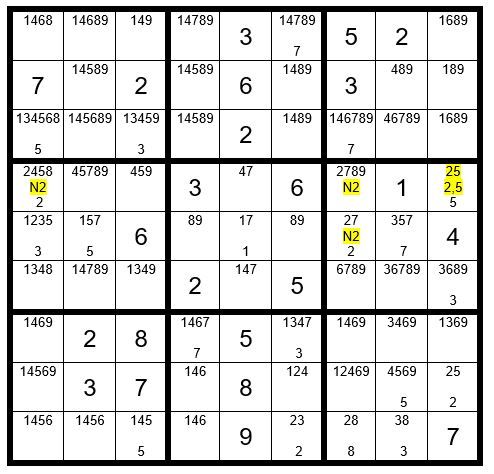
You will see above that we highlighted the driver cell in yellow, as well as the sequence 2,5 and the unsolved adjacent cells to the driver cell that contain the option 2. We are tracking the 5 in the driver cell, which has been placed in the 3rd level of that cell.
If C9R4=5, then C9R8=2, C7R9=8, C8R9=3, C6R9=2, C8R5=7, and C7R5=2. We will pause here to realize that C7R4 is not a 2, regardless if C9R4 is a 2 or 5.
Therefore, we can eliminate 2 as an option for C7R4. We will continue on with the tracking to see if we can learn anything else.
C7R3=7, C1R4=2, C5R5=1, C2R5=5, C1R5=3, C9R6=3, C6R7=3, C4R7=7, C6R1=7. C1R3=5, C8R8=5, C3R3=3, C3R9=5. Continue with the track and your grid will look like Example #74.6 below:
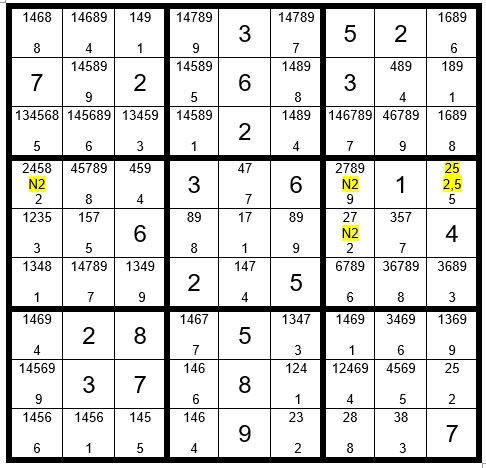
Look at each row, column and box. What do you observe? Yes, there are not any repeated numbers in any row, column or box. Therefore, 5 is the correct answer for C9R4, and we have just solved the puzzle!
May the gentle winds of Sudoku be at your back.
Dan LeKander
_________________
Clue for Puzzle #73 …
We know that the options for C3R8=24. Check out C8R8. Its options are 24 also. Enter options 24 for C8R8. The options for the remaining cells in row 8 are 356. There is already a 3 and 5 in column 5; therefore, C5R8=6, and the options for C6R8 & C9R8 are 35. Then, C4R1=6. We know that C7R1, C7R2 & C7R3 cannot be a 2; therefore a 2 must exist as an option in C8R1 or C9R1, and therefore a 2 cannot exist in any other unsolved cell in row 1. Now the options for C2R1=45, C7R1=458, C8R1=248 & C9R1=2458. This is an obvious quad. That means C1R1 & C5R1 must have options 39. There is already a 3 in column 5; therefore, C5R1=9 and C1R1=3. From here the puzzle falls apart!
Editor's Note: The start of a whole new year! A different year, yet Dan and his proofreader, Peggy, give us a new challenge each month. We start the new year with two!
Each month I copy the article - insert the examples and then shake my head as I realize just how much work goes into each one of the Dan's articles. I have the easy job, his is difficult and then you, our readers, have the challenge.
It was back in January 2016, when we published a final article in Dan's Series of Steps to learn the logic of Sudoku – he asked if we would like a puzzle to solve every month … this editor said an enthusiastic… Yes, please!
If you have not already done so, I suggest you purchase Dan’s book:


